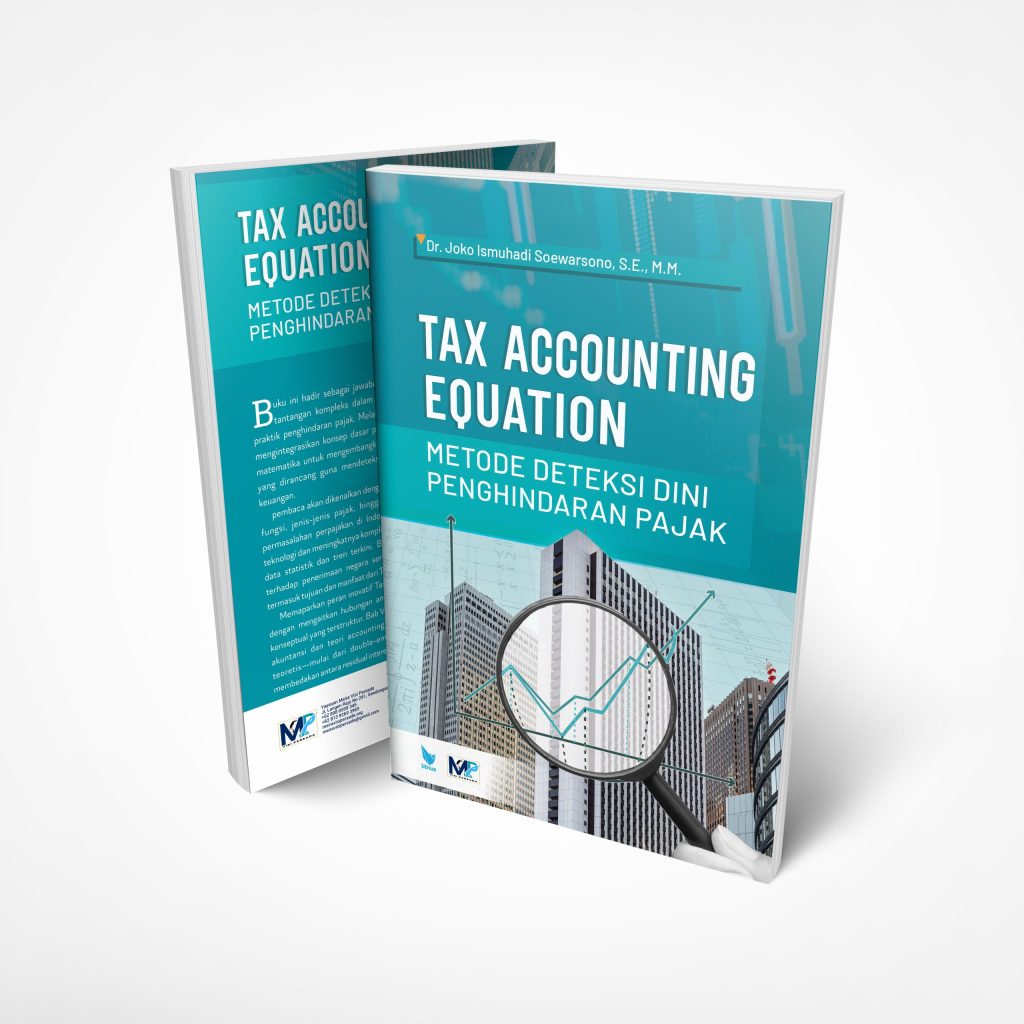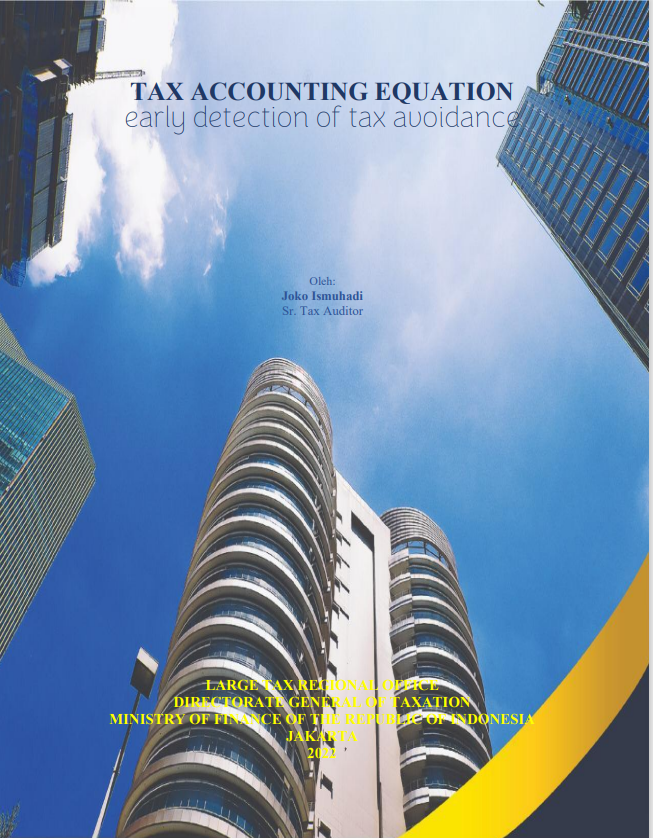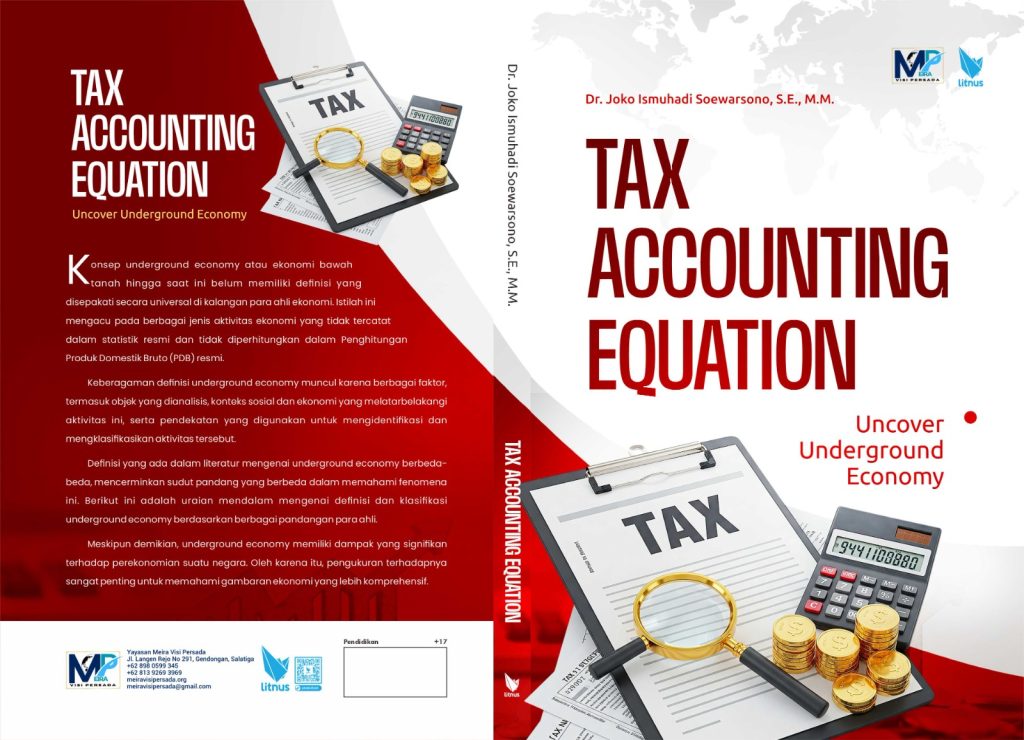
Uncovering Hidden Economic Activity: An Analysis of Dr. Joko Ismuhadi’s Tax Accounting Equation
- Ekonomi
Thursday, 03 April 2025 15:06 WIB

Jakarta, fiskusnews.com:
1. Introduction: The Challenge of the Underground Economy and the Novelty of the TAE
The underground economy, a multifaceted realm of economic activities operating outside official reporting and regulatory frameworks, presents a significant challenge to governments worldwide. Often referred to as the shadow economy, informal economy, or black market, it encompasses a spectrum of activities, both legal and illegal, that evade taxation and official scrutiny. This hidden sector undermines governmental revenue streams, fosters unfair competition for legitimate businesses, and can distort macroeconomic indicators, complicating effective economic and political decision-making. Estimates of the underground economy’s size vary considerably across nations, with some developed countries like the United States reporting figures around 11-12% of their Gross Domestic Product (GDP). However, in many developing and transitional economies, this figure can be substantially higher, reaching upwards of 30-40% of GDP, as observed in Indonesia. The sheer scale of this unreported economic activity underscores the critical need for innovative tools and methodologies to enhance transparency and facilitate better governance.
Within the Indonesian context, the underground economy poses a particularly salient issue, with various reports consistently highlighting its substantial contribution to the nation’s overall economic activity. Estimates fluctuate, but studies suggest that a significant portion of Indonesia’s economic output remains outside the formal tax system, impacting sectors ranging from agriculture and fisheries to transportation, warehousing, and the burgeoning digital economy, including online gambling. This situation has prompted Indonesian authorities to explore novel approaches to better understand and manage this hidden economic sphere. In response to this challenge, Dr. Dr(C). Joko Ismuhadi Soewarsono, an Indonesian tax practitioner and academic, has developed a “Tax Accounting Equation (TAE)” specifically designed to uncover Underground Economy Activity (UEA), particularly focusing on the detection of tax avoidance and evasion by corporate taxpayers within Indonesia. The novelty of Dr. Ismuhadi’s research lies in its attempt to reveal this hidden economic activity through a unique formulation of the accounting equation.
2. Deconstructing the Tax Accounting Equation (TAE): Formula, Variables, and Principles
To fully appreciate the potential of Dr. Ismuhadi’s TAE, it is essential to first understand the foundational principles of accounting upon which it is built. The basic accounting equation, a cornerstone of financial accounting and the double-entry bookkeeping system, establishes a fundamental relationship between a company’s assets, liabilities, and owner’s equity: Assets = Liabilities + Owner’s Equity. This equation signifies that a company’s total resources (assets) are financed by either what it owes to others (liabilities) or the investment made by its owners (equity). The expanded accounting equation provides a more detailed breakdown of owner’s equity, revealing its components such as contributed capital, retained earnings, revenues, expenses, and dividends. This expansion can take various forms, such as Assets = Liabilities + Contributed Capital + Beginning Retained Earnings + Revenues – Expenses – Dividends. These fundamental equations ensure that every financial transaction is recorded with corresponding and opposite entries, maintaining a balance in the accounting records.
Dr. Ismuhadi’s Tax Accounting Equation (TAE) presents a distinct formulation: Revenue = Expenses + Assets – Liability. In certain contexts, particularly when analyzing cash transactions, Dr. Ismuhadi also posits a variation: Revenues = (negative) Liabilities. This unique arrangement of the accounting elements is not arbitrary; it is rooted in a specific principle related to the detection of tax evasion. Dr. Ismuhadi’s approach, as indicated, stems from a “Mathematical Rationality Approach,” where the basic accounting equation (Assets = Liabilities + Equity) is expanded to the Mathematical Accounting Equation (MAE): Asset = Liability + Equity + {(Revenues – Expenses) – Dividend}. This MAE is then mathematically rearranged to derive the TAE. The underlying principle of the TAE is that it can serve as an early detection tool for tax avoidance and evasion by highlighting inconsistencies in the financial statements of corporate taxpayers. Specifically, it aims to identify situations where reported revenue does not correlate with expected increases in equity or asset accumulation but is instead offset by liabilities, potentially indicating that revenue is being mischaracterized as debt to avoid taxation.
3. TAE as a Tool for Identifying and Quantifying Underground Economy Activity
The theoretical rationale behind using Dr. Ismuhadi’s TAE to identify Underground Economy Activity (UEA) lies in its ability to scrutinize the relationship between a company’s reported revenue and its liabilities, particularly in the context of tax regulations. According to Article 4 paragraph (1) of the Indonesian Income Tax Law, income is defined as any additional economic capacity received or obtained by the taxpayer that can be used for consumption or to increase wealth. Dr. Ismuhadi’s TAE can test whether corporate taxpayers are making a significant contribution to corporate income tax or if there is no change in equity from retained earnings and no declaration of dividends. If these conditions are met, the TAE in the form of Revenue = Expenses + Assets – Liabilities aligns with the definition of income for tax purposes. However, Dr. Ismuhadi emphasizes that this definition does not explicitly state that income can be used to reduce liabilities. This distinction is crucial for detecting potential tax avoidance.
The TAE, especially the formulation Revenues = (negative) Liabilities, becomes particularly relevant when examining cash transactions. Dr. Ismuhadi argues that some corporate taxpayers have a tendency to underreport sales revenue by utilizing cash transactions. The cash received from these unreported sales is then reintroduced into the financial system as a repayment of debt (liabilities). This creates a scenario where the increase in cash (an asset) is offset by a decrease in liabilities, without a corresponding increase in reported revenue or equity. This type of transaction, often referred to as a “back-to-back loan” or “parallel loan,” can be used to obscure the origin of funds, making it appear as though the money came from debt disbursement (which is not typically a taxable event) rather than from sales proceeds (which are taxable). By analyzing financial reports through the lens of the TAE, tax authorities can potentially identify such discrepancies and flag transactions that warrant further investigation.
While the TAE appears to be effective in identifying potential instances of tax evasion at the individual company level by highlighting anomalies in their financial data, the provided research material offers limited insight into how the TAE can be directly used to quantify the overall scale of Underground Economy Activity (UEA). The focus seems to be more on detecting suspicious transactions and potential underreporting of revenue rather than on extrapolating these findings to estimate the total value of the hidden economy. Therefore, based on the current information, the TAE appears to be primarily a forensic tool for identifying potential tax evasion rather than a macroeconomic tool for quantifying the entirety of UEA.
4. Practical Applications and Case Studies of TAE
The research material provides specific instances where Dr. Ismuhadi’s Tax Accounting Equation (TAE) has been applied in practice, primarily within Indonesia. One notable case involves the Duta Palma Group, an integrated palm oil plantation industry. According to Dr. Ismuhadi, the TAE helps explain how this corporation might have stored large amounts of cash, which were potentially from unreported sales revenue. The TAE, in the formulation Revenues = (negative) Liabilities, suggests that the company may have avoided reporting cash sales as revenue and instead later channeled this cash back into the financial system as debt repayment. This “back-to-back loan” scheme allows the company to present the funds as originating from debt disbursement rather than from taxable sales revenue. This case illustrates how the TAE can be used to analyze specific financial activities and identify potential tax evasion strategies involving the mischaracterization of revenue as debt.
Furthermore, the research mentions that Dr. Ismuhadi has documented “several case examples” in his book that serve as references for the early detection of tax avoidance and/or evasion using the TAE. While the specifics of these other cases are not detailed in the provided snippets, their existence suggests that the TAE is not just a theoretical concept but has been applied to analyze various real-world financial scenarios to identify potential tax irregularities. Additionally, there is a mention of “Laporan Keuangan PT Wilmar Cahaya Indonesia” (Financial Statements of PT Wilmar Cahaya Indonesia) alongside the TAE, potentially indicating another case study where the TAE has been utilized, although the exact nature of this application is not elaborated upon. The predominant focus of these practical applications is within the Indonesian context, and the research material does not provide information on the TAE being applied in other regions. This suggests that the development and initial validation of the TAE have been primarily centered on addressing the specific challenges of tax analysis and the underground economy in Indonesia.
5. Advantages and Limitations of the Tax Accounting Equation
The Tax Accounting Equation (TAE) developed by Dr. Ismuhadi presents several potential advantages as a tool for tax authorities. Foremost among these is its capacity for early detection of tax avoidance and/or evasion. By providing a framework to analyze the relationships between key accounting variables like revenue and liabilities, the TAE can help flag potentially suspicious financial activities before they escalate or become deeply entrenched. This proactive approach could allow tax authorities to intervene earlier in the process, potentially leading to more efficient audits and higher rates of tax recovery.
Another advantage of the TAE is its targeted nature. The equation, particularly the focus on the Liability (Bank Overdraft) account as suggested in the research, can guide tax auditors to concentrate their efforts on specific areas of a company’s financial records that are deemed more likely to be involved in tax evasion schemes. This focused approach can optimize the use of limited audit resources, making the tax auditing process more efficient and effective. Furthermore, the derivation of the TAE from the fundamental accounting equation using a “Mathematical Rationality Approach” suggests a structured and potentially objective method for identifying anomalies in financial data. This mathematical foundation might lend a degree of rigor to the analysis, reducing reliance on purely subjective interpretations of financial statements.
Despite these potential benefits, the TAE also likely has certain limitations. As it is based on reported accounting data, the effectiveness of the TAE is contingent upon the accuracy and completeness of this information. Sophisticated taxpayers engaging in tax evasion might employ creative accounting practices to manipulate their financial records in a way that does not trigger the red flags identified by the TAE. The TAE, as currently presented, appears to primarily focus on corporate tax evasion, particularly through the mischaracterization of revenue as debt. Its applicability to other forms of underground economic activity, such as tax evasion by individuals or the vast informal sector, might be limited. Additionally, relying solely on a single equation might oversimplify the complex and multifaceted nature of tax evasion and the underground economy, which are influenced by a wide array of economic, social, and legal factors. Therefore, while the TAE offers a valuable tool for tax analysis, it is likely most effective when used as part of a broader suite of analytical methods and enforcement strategies, rather than as a standalone solution.
6. Reception and Academic Discourse on Dr. Ismuhadi’s Work
The reception of Dr. Ismuhadi’s work on the Tax Accounting Equation (TAE) appears to be primarily within Indonesian financial and policy circles. His profile on ResearchGate indicates his affiliation with Padjadjaran University and the Directorate General of Tax in Indonesia. While his profile lists a couple of conference papers from 2022, these publications focus on intellectual property rights and legal protection for online loan debtors, and do not directly address the TAE. The numerous mentions of Dr. Ismuhadi and the TAE in Indonesian news articles and documents on platforms like Scribd suggest that his work is known and discussed within the country. The categorization of articles related to his work under “Pendidikan” (Education) and “Ekonomi” (Economy) by Indonesian news outlets further indicates its relevance in these domains. However, the limited presence of peer-reviewed academic publications specifically detailing and analyzing the TAE in international academic databases suggests that the concept might be relatively new or primarily disseminated through more practitioner-oriented channels within Indonesia.
At the policy level in Indonesia, Dr. Ismuhadi’s TAE seems to have garnered attention. References to the “Persamaan Akuntansi Pajak oleh Dr. Joko Ismuhadi Soewarsono Menutup Celah Pajak dengan Mengubah Pasal 4 Ayat (1) UU PPh” (Tax Accounting Equation by Dr. Joko Ismuhadi Soewarsono Closes Tax Loopholes by Amending Article 4 Paragraph (1) of the Income Tax Law) indicate that his work is being considered in the context of potential tax policy changes in Indonesia. Furthermore, discussions involving the Head of the KPP (Tax Service Office) regarding the TAE as an early detection tool for tax avoidance and evasion suggest engagement with Indonesian tax authorities. Dr. Ismuhadi’s insights on the TAE have also been sought by news outlets covering financial issues, as evidenced by his explanation of the Duta Palma Group case using the equation. This level of engagement with policymakers and tax authorities within Indonesia suggests a degree of recognition and potential influence of Dr. Ismuhadi’s TAE in the country’s efforts to address tax evasion and understand aspects of the underground economy.
7. Comparing TAE with Existing Methodologies for Measuring the Underground Economy
Dr. Ismuhadi’s Tax Accounting Equation (TAE) represents one approach to understanding and potentially quantifying aspects of the underground economy, particularly tax evasion. However, a range of alternative methodologies has been developed and employed by economists and researchers to measure the size and impact of this hidden economic activity. These methods can be broadly categorized into direct and indirect approaches. Direct methods, such as tax audits and surveys, attempt to directly measure unreported income or activities. Indirect methods, on the other hand, use macroeconomic indicators to infer the size of the underground economy.
One of the most widely used indirect methods is the Monetary Approach, also known as the Currency Demand Approach (CDA). This approach operates on the assumption that transactions in the underground economy are primarily conducted using cash to avoid detection by authorities. By analyzing the demand for currency in relation to factors like the tax burden, researchers can estimate the amount of cash being used in the hidden economy and, by extension, its size. Another prominent indirect method involves MIMIC (Multiple Indicator Multiple Cause) models. These are statistical models that treat the underground economy as a latent variable, influenced by various causes (e.g., tax rates, unemployment) and reflected in several indicators (e.g., currency in circulation, labor force participation). By analyzing the relationships between these observed variables, the size of the unobserved underground economy can be inferred. Other methods include analyzing discrepancies in national income accounting, using labor force estimates, and employing physical input methods like electricity consumption.
Dr. Ismuhadi’s TAE differs significantly from these macroeconomic methodologies. It is fundamentally a micro-level, accounting-based approach focused on scrutinizing the financial statements of individual companies to detect potential tax evasion. While methods like the CDA and MIMIC models aim to estimate the overall size of the underground economy at a national or regional level using aggregate data, the TAE delves into the specific financial data of firms to identify anomalies that might indicate unreported income being disguised as debt. The TAE’s reliance on company-level financial data contrasts with the macroeconomic indicators used in other methods. Its strength lies in its direct connection to accounting principles and tax regulations, potentially providing more specific and actionable insights for tax authorities at the firm level. However, it may not offer a comprehensive measure of the entire underground economy, which includes activities beyond corporate tax evasion.
| Methodology | Data Requirements | Underlying Assumptions | Key Formula/Approach | Strengths | Weaknesses | Applicability (Micro/Macro) | Example |
| Tax Accounting Equation (TAE) | Company-level financial statements | Discrepancies between revenue and liabilities indicate potential tax evasion. | Revenue = Expenses + Assets – Liability; Analysis of the relationship between revenue and liabilities, especially in cash transactions. | Targeted detection of potential corporate tax evasion. | Relies on accuracy of reported data; Limited scope beyond corporate tax evasion. | Micro | Analysis of Duta Palma Group’s financial transactions. |
| Monetary Approach (Currency Demand Approach) | Aggregate currency in circulation, tax rates, GDP, etc. | Underground transactions are primarily conducted in cash. | Econometric modeling of the demand for currency as a function of tax burden and other variables. The “excess” currency demand is attributed to the underground economy. | Provides an estimate of the overall size of the underground economy. | Sensitive to assumptions about cash usage and velocity of money. | Macro | Estimates of Indonesia’s underground economy based on currency demand. |
| MIMIC (Multiple Indicator Multiple Cause) | Macroeconomic indicators and causal factors | The underground economy is influenced by certain observable causes and reflected in indicators. | Statistical modeling using latent variable techniques to estimate the size of the unobserved underground economy based on its assumed causes (e.g., tax burden, regulation) and indicators (e.g., currency). | Accounts for multiple factors influencing and reflecting the underground economy. | Results can be sensitive to the selection of indicators and causes. | Macro | Studies using MIMIC models to estimate the shadow economy. |
| Tax Audits | Tax audit data | Tax audit findings can be extrapolated to the entire population. | Examination of tax returns and financial records to identify unreported income and tax evasion. The identified tax gap is used as an indicator of the underground economy. | Direct assessment of tax evasion at the individual level. | Audit selection may not be random, potentially leading to biased estimates. | Micro/Macro | Extrapolation of tax audit findings to estimate the size of UEA. |
| National Income Accounting Discrepancies | National income and expenditure data | Differences between income and expenditure sides of national accounts reflect hidden activity. | Comparison of independently calculated measures of national income and expenditure. The difference is attributed to the underground economy. | Uses official macroeconomic data. | Difficult to isolate the underground economy from other statistical discrepancies. | Macro | Comparing income and expenditure sides of GNP. |
8. The Underground Economy in Indonesia: Current State and the Potential Impact of TAE
The Indonesian economy is characterized by a significant and persistent underground sector. Estimates from various studies place its size between 8.33% and 40% of the nation’s GDP. This substantial hidden economic activity affects numerous sectors, including agriculture, fisheries, transportation, warehousing, and the rapidly expanding digital space, notably online gambling. Illegal imports also constitute a significant portion of this underground economy. The sheer scale of this unreported economic activity presents a considerable challenge for tax collection and overall economic management in Indonesia.
Given that Dr. Ismuhadi’s Tax Accounting Equation (TAE) is specifically designed to detect corporate tax evasion, its implementation could have a notable impact on addressing the segment of the Indonesian underground economy that involves underreporting of profits by registered businesses. The case of the Duta Palma Group exemplifies the TAE’s potential in uncovering sophisticated tax avoidance schemes, such as the mischaracterization of sales revenue as debt through back-to-back loan transactions. By providing Indonesian tax authorities with an “early detection tool” for such practices, the TAE could enable a more proactive and targeted approach to tax auditing and enforcement, potentially leading to the recovery of substantial amounts of lost tax revenue. Furthermore, the TAE’s alignment with Article 4 paragraph (1) of the Indonesian Income Tax Law enhances its relevance and potential impact within the existing legal and regulatory framework of the country. If effectively adopted and integrated into the tax audit procedures, the TAE could serve as a valuable asset for Indonesian tax authorities in their ongoing efforts to improve tax compliance among corporations and curb a significant portion of the underground economy associated with tax evasion by registered entities.
9. Conclusion and Recommendations
Dr. Joko Ismuhadi’s Tax Accounting Equation (TAE) offers a novel, accounting-based approach to identifying potential tax evasion, particularly within the context of corporate taxpayers in Indonesia. The TAE, with its core formula Revenue = Expenses + Assets – Liability and its underlying principle of detecting discrepancies between reported revenue and liabilities, provides a unique lens for analyzing financial statements and flagging suspicious transactions, such as those involving back-to-back loans. Case studies, like the one involving the Duta Palma Group, suggest the practical applicability of the TAE in uncovering sophisticated tax avoidance schemes. The potential advantages of the TAE include its capacity for early detection, its targeted nature in focusing audit efforts, and its grounding in mathematical accounting principles. However, limitations such as reliance on the accuracy of reported data and a potentially limited scope beyond corporate tax evasion should also be considered.
While Dr. Ismuhadi’s work appears to be gaining traction within Indonesian financial and policy circles, further peer-reviewed academic research is needed to rigorously validate the theoretical underpinnings and empirical effectiveness of the TAE. It would also be beneficial to explore methodologies that could potentially link findings from the TAE to broader estimations of the underground economy’s size. Investigating the adaptability of the TAE to different international contexts and comparing its effectiveness with other tax audit techniques would also be valuable avenues for future research.
For Indonesian tax authorities, incorporating the TAE into their audit procedures, especially for large corporate taxpayers, warrants consideration. Providing specialized training to tax auditors on the principles and application of the TAE would be crucial for its successful implementation. Exploring the development of software tools to automate the application of the TAE to large financial datasets could further enhance its efficiency. Fostering ongoing collaboration between academics like Dr. Ismuhadi and tax authorities would be essential for refining the TAE based on practical experience and the evolving landscape of tax evasion tactics. In conclusion, while the TAE is not a panacea, it represents a promising tool that, when used in conjunction with other analytical methods and enforcement strategies, could contribute significantly to the ongoing efforts to understand and address the challenges posed by the underground economy in Indonesia.
Reporter: Marshanda Gita – Pertapsi Muda
Share
Berita Lainnya
Potensi Koperasi Desa Merah Putih dalam Formalisasi Ekonomi Bawah Tanah dan Peningkatan Pendapatan Pajak di Indonesia
P3KPI selenggarakan Edukasi Coretax
Analysis of Accounting Equations, Underground Economy, Crude Palm Oil Markets, and Forex Hedging
Misi AHY Jadi Menteri ATR/BPN: Beri Kepastian Hukum ke Investor
Rekomendasi untuk Anda

Berita Terbaru
Eksplor lebih dalam berita dan program khas fiskusnews.com
Tag Terpopuler
# #TAE
# #TAX ACCOUNTING EQUATION
# #TAX FRAUD
# #TAX EVASION











